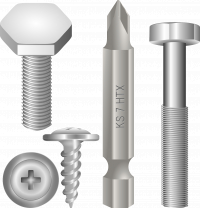Which way to screw and unscrew a screw or bolt
To screw:
To screw , the standard is to turn clockwise : 
Be careful, take into account your orientation in relation to the screw. If the screw is upside down (for example under a table) and you are above it, remember to turn your hand in the right direction with respect to the screw.
To unscrew:
To unscrew a screw, you must always turn counterclockwise:
"I still can't get my screw in or out!"
Turning the screwdriver the right way, but still can't get it right? There are probably several possible reasons:
1. If you try to screw
- Make sure you are aligned with the hole you want to fit the screw into. Once right in front, exert light pressure on the screw (holding firmly at the junction of the screwdriver and the screw to avoid injury) and start screwing in a clockwise direction.
- If there isn't a hole you need to screw your screw into (usually in wood), hold your screw firmly with one hand and your screwdriver with the other. Make sure you are perpendicular to the object that will accommodate the screw and slowly start to exert pressure on the screw just before starting to screw (be careful not to slip so as not to get the screwdriver into the holding finger. the opinion !).
Exert more and more pressure until the screw sinks very lightly into the object and creates the thread necessary to retract the screw.
If you still can't screw in your screw because the material is too hard, you can use a hammer to gently hammer the end of the screw in before you start screwing.
2. If you try to unscrew
- If you are sure you are turning your screw counterclockwise, it is likely that your screwdriver is not suitable for your screw or that the screw is stuck (it's a common problem if the screw is screwed in a nut or in metal that has oxidized).
- Check that your screwdriver is suitable for your screw. It is important that the screwdriver matches the screw you are trying to tighten. A screwdriver that is too large or too small will often prevent you from tightening or unscrewing your screw.
- Check that your screw is not seized by rust or oxidation (red / brown mark).
If your screw is in contact with metal, air or water may have created rust around your screw and "welded" your screw. In this case, use a penetrating product to spray your screw, wait for the product to act and try to unscrew it again.


